Physical Address
304 North Cardinal St.
Dorchester Center, MA 02124
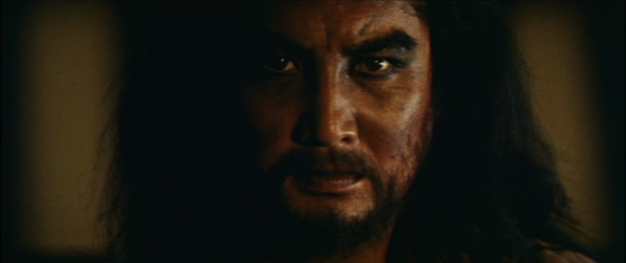
(Continued from Page 1)
I found it extremely hard to write this review, much more difficult than any of the others, not just because Miyamoto Musashi – considered as a single, five-part entity – is Uchida’s longest work by far – it’s more than triple the length of the most complete existing version of A Fugitive from the Past, the director’s longest single-part film – but because, even after multiple viewings of the complete work, I simply don’t care for it much, or at least not as much as other critics and fans seem to. And I definitely don’t care for the protagonist, though he’s probably the most celebrated hero in all Japanese history.
It’s only fair to note that the pentalogy was probably the most commercially successful work of the filmmaker’s entire fifty-year career. According to Stuart Galbraith, the first film in the series was the fourth biggest box office hit of 1961 (Kurosawa Akira’s Yojimbo was third), though the later installments, while successful, apparently made less money.1
Part One of the series does exactly what it’s supposed to do: it brings the viewer into Musashi’s story and his world, including those events and people that led him to become Musashi in the first place, and keeps the viewer engrossed throughout. This is despite the fact that the main dramatic conflict of the whole series – the rivalry between Miyamoto and his arch-adversary, the great swordsman Sasaki Kojirō – has not even been introduced yet into the epic narrative. By pulling off this challenging feat, Uchida created a first-rate work of cinematic craftsmanship.
It’s very debatable, however, whether this film, along with the four later films in the series, aspire to any higher aesthetic goal. The best of the director’s previous works – among them, Police Officer (1933), the tragically mutilated Unending Advance (1937), the similarly-incomplete Earth (1939), A Bloody Spear at Mt. Fuji (1955), Chikamatsu’s Love in Osaka (1959), Hero of the Red-Light District (1960), The Mad Fox (1962) and his masterpiece, A Fugitive from the Past (1965) – all managed to transcend the conventions of their genres to deliver memorable artistic experiences, but in my view this series only intermittently achieves that. The British writer Graham Greene famously divided up his oeuvre into two categories of books: serious novels and “entertainments,” with the former category reserved for books dealing with weighty religious or philosophical themes (e.g., The Power and the Glory), and the latter consisting mostly of commercial thrillers (e.g., Brighton Rock, though these sometimes also tackled themes similar to the “serious” books). If we were to do the same for Uchida – though he would surely have objected – and split his works into “serious cinema,” such as Earth and A Fugitive from the Past, and commercial “entertainments,” the Musashi pentalogy would definitely appear in the latter category.
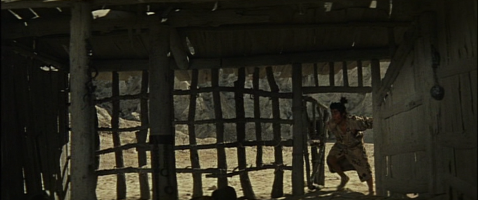
In this first installment of the series, true, there’s one almost dialogue-free scene that’s truly haunting: Musashi’s arrival at Hinagura to rescue his imprisoned sister, Ogin, only to discover, to his horror, that the place is completely deserted. The sequence is effectively filmed entirely in medium and long shot, and the lack of close-ups paradoxically stresses the helplessness and despair of Musashi, who appears as a tiny, weak figure in this empty landscape.
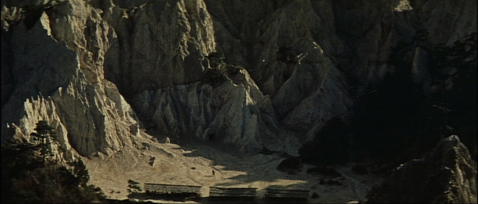
The scene suggests a movie by Nakagawa Nobuo, director of the famous horror film Yotsuya Ghost Story (Tōkaidō Yotsuya kaidan, 1959), or, perhaps more appropriately, Teshigahara Hiroshi’s avant-garde debut feature Pitfall (Otoshiana), released in 1962, the year after the first part of Uchida’s series came out. The Teshigahara work, which is about ghosts who wander through a desolate wasteland trying to understand how and why they died, conveys much the same eerie sense of alienation as this scene.
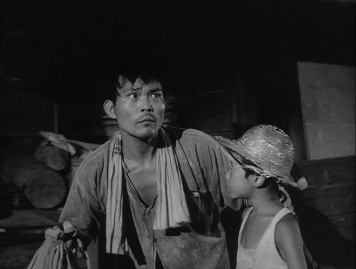
The big difference is that in the Teshigahara work, the sense of strangeness and alienation is sustained throughout the whole work, whereas in Uchida’s film, Musashi’s futile search for his sister is an exceptional moment within a more or less conventional movie. It is significant that the Ogin subplot is abruptly dropped in subsequent installments in the series and she’s almost never mentioned again. Nothing apparently, not even the protagonist’s loyalty to a family member in distress, is ever allowed to distract from the narrative arc of Musashi’s “enlightenment.”
I put that last word in quotes in the paragraph above because the saga of Musashi’s struggle toward “wisdom” (those quotation marks again) is extremely problematical for me. To put it bluntly, I don’t think the protagonist is a better or wiser person at the end of the series than at the beginning. It could be argued, in fact, that he’s much worse.
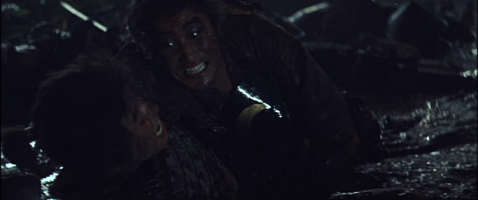
At the start, when the protagonist is a naively ambitious bumpkin setting out to make his name as a warrior, he’s depicted unflatteringly as a violent and undisciplined hothead. Yet it’s highly unlikely that this young man, wild as he is, would ever be capable of the cold-blooded murder of a child – which is exactly what happens in Part IV, after Takezō/Musashi has been spiritually “transformed.” (I’ll have more to say about this in my commentary to that installment in the series.) Thus, his vow at the end of Part One to honor and respect life is the most hollow of promises.
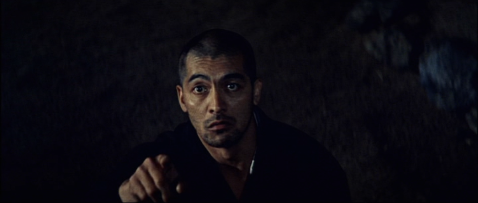
I must confess that my opinion of the protagonist is skewed by my religious background, which, for better or worse (I’m no longer a practicing Christian), continues to shape my worldview. Within that perspective, the sin of all sins is pride. The proud person, in this narrow theological sense, places himself and his own needs not only above those of other people, but those of God. Thus, it’s difficult for me to perceive Musashi’s wanderings throughout Japan, seeking duels through which to hone his skills (and broadcast his fame), as driven by anything other than ego, and certainly not by a quest for “self-improvement.”
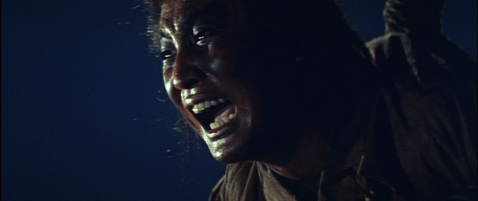
Admittedly, the scene in which Takezo is tied up and left hanging in the cedar tree to die, and the priest Takuan forces him to admit that he’s nothing but an animal, is a deeply moving, classic redemption scene. But afterwards, he does not become less violent, but more violent – he’s just more cold-blooded about it. So with a redemption like this, who needs damnation?
Musashi’s reputation in Japan as “The Ultimate Samurai” (which is the title of the U.S.-released DVD box set of the five-film series, issued by AnimEigo) seems to me extremely strange. For most of his life, according to this movie and most others that depict him, as well as print sources such as Wikipedia, he did the exact opposite of what a samurai is supposed to do, which is to serve those above him in the hierarchy. In fact, according to Wikipedia, the word “samurai” itself is derived from the verb saburau, which means “to wait upon,” and its nominalized form, saburai, means “one who serves.”2
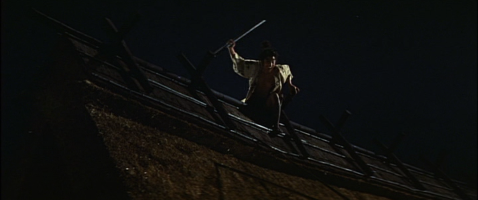
Despite his legendary skill as a swordsman, however, Musashi, for most of his life, seemed averse by temperament to submitting to any authority whatsoever. This waywardness makes him almost unique in the samurai tradition. Even Kurosawa’s fictitious Seven Samurai – who are actually five ronin (masterless samurai), plus one young samurai trainee and a peasant imposter – steadfastly serve the farmers they’ve freely chosen to defend, though not without ambivalence.3
What is truly remarkable, though, is the degree to which Uchida himself consistently undercuts his otherwise conventional view of his hero. Whenever Uchida tries to present his protagonist as an exemplary figure, it’s as if he has to add the words: “Yes, but…” Yes, Musashi is brave… but he does seem to run away from many of his fights. Yes, he is a shrewd tactician… but some of his tactics, such as consistently showing up late for duels to psych out his adversaries, are tantamount to cheating. Yes, he loves children… but he did murder in cold blood the innocent, unarmed boy Genjirō. Yes, he reveres the code of bushido… but he did blind a man, Hayashi, who had been expelled from the Yoshioka clan and thus wasn’t part of Musashi’s feud with that clan – a serious breach of samurai ethics.
By the end of the series, Musashi’s “heroism” has become so riddled with ethically and morally dubious behavior that one begins to wonder whether the arrogant and overbearing but unhypocritical Sasaki Kojirō ought to be considered the epic tale’s true hero. At least Sasaki, unpleasant though he is, never killed a little boy.
Gregory Barrett, in his book Archetypes in Japanese Film, has addressed these issues in his commentary on Uchida’s pentalogy, which appears alongside his analyses of previous cinematic depictions of Musashi by other filmmakers. Barrett’s revulsion for the character as depicted by Nakamura is palpable. He describes this Musashi as “not only savage but cruel,” and points out that the director’s depiction of violence in the series was much more graphic than previous versions of the Miyamoto story, noting that “the bloodthirsty rages of his Musashi overshadow signs of spiritual development.”4 Barrett claims that the filmmaker, unlike novelist Yoshikawa, deliberately de-emphasized the importance of Zen to the protagonist, while emphasizing the ronin’s peculiar interpretation of the Way of the Sword as the need to win at any cost. This Musashi, Barrett writes, “needs a keeper instead of a teacher.”5
“From Uchida’s portrayal of Musashi as a savage, narcissistic megalomaniac,” continues Barrett, “it is obvious the director did not like his subject.”6 But is it so obvious? In my own mind, there’s no doubt that Uchida felt, at the very least, a great deal of ambivalence towards his hero. But to what degree would Uchida have agreed with Barrett? The answer to that question is crucial for our understanding of the artist’s intentions:
This last possibility fascinates me. I will explore this interpretation in detail in my Commentary to Part V of the series.
The monk Takuan returns to the darkened room in Shirasagi Castle where he had left Takezō three years earlier so that the ronin could begin his quest for wisdom through books. The young swordsman is now delighted to see his former enemy, and greets him as his master. Takuan announces that Takezō is finally ready to leave the room and go out into the world again. The monk gives the young man a new, more dignified given name: “Musashi,” an alternate reading of the kanji characters of his birth name, and the name of his village, Miyamoto, has become his surname. Musashi embarks on the life of a wandering swordsman to seek enlightenment.
Musashi journeys to Hamada Bridge because Otsu had promised to meet him there, and is astonished to find that she’s still living nearby, waiting for him. Regretfully, he tells her that the life he will lead would be inappropriate for a woman and departs, leaving her in tears.
Meanwhile, Okō and her “daughter” Akemi are employed by the Young Master of the Yoshioka dojō (fencing school), Seijurō. Though Okō is married to Matahachi, she openly engages in an affair with Seijurō’s underling, Toji. The drunken and indolent Matahachi accuses her of ruining his life. Akemi is raped by the Young Master.
A member of the dojō informs Matahachi that a young swordsman from Miyamoto Village named Musashi is challenging, and defeating, the students, causing them all to lose face. The man says that the challenger had sworn he wouldn’t leave until the Young Master returns to fight him. Matahachi figures out that Musashi is his old friend, Takezō.
Seijurō arrives at the dojō but is persuaded by one of his attendants, Yokoyama Kansuke, that if he fights Musashi, the honor of the clan would suffer whether he wins or loses. They decide to ambush and kill Musashi, but discover that he’s already escaped.
At Hongondo Shrine, Musashi is approached by the still-vengeful Obaba and her husband Gon, as well as an armed retinue of men supporting her cause. Musashi, who doesn’t want to kill Obaba nor be trapped by the old woman’s foolish supporters, is forced to run away again.
Musashi befriends a young boy, Jotarō, who lives in a liquor shop with his uncle. He discovers to his shock that the boy is the son of Aoki Tanzaemon, who had hunted him when he was a fugitive. Musashi agrees to take on Jotarō as his disciple.
As Musashi leaves for Nara, the boy gives him a message from a drunk who had come to the liquor shop, and Musashi realizes that this was Matahachi. The samurai in turn gives the boy a message to give to Seijurō of the Yoshioka dōjō. He also instructs the child to find Matahachi and tell him that he will be waiting for him at Gojo Bridge during the first week of the New Year.
When Musashi arrives at Hozo-in Temple, he encounters a priest, Nikkan, working the earth with a hoe. Perceiving him as a possible enemy, Musashi leaps over him, preparing for an attack. Yet the man keeps digging, apparently oblivious.
Musashi is then ushered into the dōjō. He witnesses a master spearman, the gigantic monk Agon, easily defeat a strong challenger. During their match, Agon prepares to attack Musashi, but before he can strike, the latter hits him full force with his wooden sword (bokken), killing him, and quietly leaves the hall.
Nikkan asks to speak to him and he enters the priest’s austere room. Nikkan recalls the incident in which Musashi, upon his arrival, had jumped over him; he reveals that he was fully aware of the swordsman’s presence and, sensing the violence of his personality, had prepared himself mentally for an attack. Thus, Musashi had perceived a danger that didn’t exist: a sign of weakness. Humiliated, the ronin leaves the temple.
He enters the city of Nara, which is full of brutal ronin who recognize him as the man who killed Agon. He accepts the hospitality of a woman at a nearby house. As soon as Musashi settles in, she reveals the real reason why he’s been welcomed so warmly: the town’s women want him to protect them from the dangerous gang of ronin. He agrees to help them.
Musashi is visited by three ronin who compliment him on his victory over Agon. They ask him to participate with them in a local martial arts tournament and offer to share their winnings with him. He indignantly refuses this corrupt deal, and they vow revenge. Jotarō arrives and gives Musashi the written reply from the Yoshioka dojō, which says that if he doesn’t engage in a duel with Seijurō by the winter, he’ll be branded a coward. He burns this letter.
Musashi prepares to leave town with Jotarō, but is informed that the monks of Hozo-in Temple – led by Inshun, who’s just returned to Nara – have gathered at Hannya Hill, bent on revenge. Ronin are also situated at every crossroads to prevent his escape. The young samurai goes forth to confront the monks with Jotarō. The boy pleads with him to run away, but the samurai rudely pushes the boy to the ground, declaring that he’s unworthy of being his disciple.
At Hannya Hill, the monks emerge to confront him. Musashi truthfully denies that he had written and posted posters slandering the monks, as the ronin are claiming. When the ronin attack him, he begins to kill them, while the spear-carrying monks do nothing. Several ronin beg Inshun to order the monks into the fight against the master swordsman, but Inshun’s men start attacking the ronin instead, killing them.
Musashi, confused, asks Inshun why the monks decided to ally themselves with him. Inshun explains that the monks were never, in fact, either his allies or his enemies. They had simply used the pretext of a fight with the samurai to defeat the brutal ronin – their real adversaries.
Nikkan arrives and explains to Musashi that it was he who had conceived this plan to rid the city of the ronin. Now the monks are happy, the town’s women are happy, the local magistrate is happy… and the ravens in the field are happy, because they can feed off the corpses. The priest departs, and the furious and humiliated Musashi declares, “I do not use my sword to pray. I use it to win!”
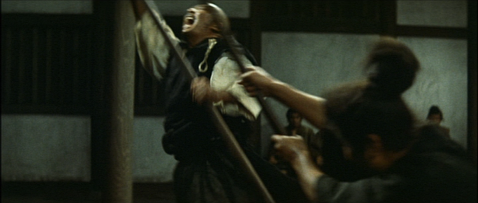
This seems to me the weakest of all five parts of the series. The big fights that the narrative so carefully sets up mostly either fizzle out (e.g., the challenge at the Yoshioka dojō, the absurd fight with Obaba) or end in anticlimax (e.g., the final duel at Hannya Hill, where the monks, not Musashi, kill most of the ronin). The only exception – the sole confrontation that is in any way satisfying – is the killing at Hozo-in Temple of mighty Agon, the spear-wielding giant monk, destroyed by a single, well-placed blow from Musashi’s bokken.7
This installment obviously isn’t the one that justifies the series’ reputation as an action classic. In fact, it’s very fortunate for Uchida that the first installment was so strong, as that initial film probably motivated many young fans of Toei swordfight films not to give up on the series after this speed bump of a movie.
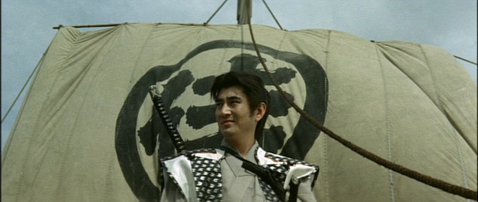
Worse than this weakness is an omission that I would claim represents a significant structural flaw in the work as a whole: namely, that Sasaki Kojirō, Musashi’s arch-adversary, isn’t introduced in this film, and indeed does not appear until well into Part Three, when the entire work is nearly half over. It makes perfect sense that the Sasaki character should be absent from the first part, in which Takezō/Musashi’s worst enemy is, quite obviously, himself. But once the protagonist sets out on his journey as an itinerant swordsman in this film, there’s no reason why the Sasaki character couldn’t somehow have been shoehorned into the narrative.
Uchida was apparently trying to be faithful to the sequence of events in the book. But in many of his other films, particularly those derived from classical theater, he had diverged from his source material in much bolder ways, so he did not have to be so conservative.
Strangely enough, Musashi’s most important relationship in Part II is not with Otsu or Matahachi or even the monk Takuan, but with the boy, Jotarō. This is consistent with other Uchida films in which the protagonist teams up with a child sidekick, such as, for example, A Bloody Spear at Mount Fuji and The Outsiders. And in The Horse Boy, a roguish child is the protagonist, whose best friend turns out to be his biological father.
Young boys are therefore as important to Uchida’s postwar cinema as they are to Ozu’s or Shimizu Hiroshi’s films – though the function of such child characters in Uchida’s work is quite different. In place of Ozu’s young rebels, mischievously challenging the patriarchal order – in Good Morning (Ohayo, 1959), for example – or of Shimizu’s self-contained child communities – in Children of the Beehive (Hachi no su no kodomotachi, 1948), especially – Uchida’s little boys are disciples, apprentices to be mentored by the adult protagonist. This is a classic, spiritual father-son bond, not dissimilar to the mentor-disciple relationships in many of Kurosawa’s films.
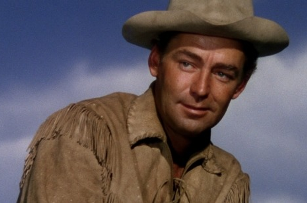
This dynamic reflects the apparently very strong influence of George Steven’s famous western Shane (1953) on Uchida’s postwar cinema. In that film, the knight-errant gunman Shane (Alan Ladd) arrives at an isolated settlement to assist a family of ranchers who are struggling to resist a cattle baron who’s trying to drive them off their land, becoming in the process a hero to the son of the family, Joey (Brandon de Wilde). In the end, his job done, Shane moves on, abandoning the boy, who, in a blatantly sentimental scene, cries out as the gunman departs, begging him in vain to return. (For the record, I agree with Pauline Kael that Stevens’ film is overrated, though Woody Allen, of all people, likes it a lot.)
Uchida’s apparent obsession with that Hollywood film may reflect an episode in his own life story. The abandonment by Shane of the little boy Joey – the gunman’s surrogate son, who is drawn much more strongly to the wandering outlaw than to his own father – may have recalled, for Uchida, his eight-year abandonment of his own sons to pursue his dreams (though it’s still unclear what those dreams might have been) in distant Manchuria, as well as the guilt that decision produced in him. Yet the bond between Musashi and Jotarō can’t be reduced to an idealized quasi-paternal one, because Uchida, to his credit, doesn’t gloss over the contradictions and tensions in that relationship.
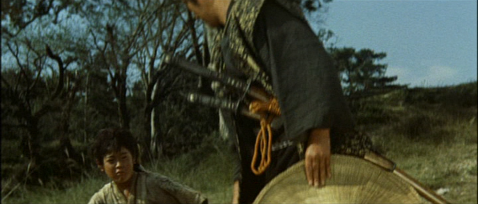
When Musashi sets out for his final quarrel with the monks at Hannya Hill, Jotarō tries to dissuade him from the fight, at first quietly, then more and more stridently. Interestingly, Musashi admits that he, too, is scared and would like to run away, but cannot avoid this destined fight. However, when the boy even more emphatically insists that the samurai escape, the latter turns on him, pushing him to the ground and declaring him unworthy of being his disciple.
This incident proves that Musashi’s affection for children, portrayed in the series as one of his most attractive traits, is skin deep. At this point, he has no real empathy for or understanding of the boy, though he and Jotarō will later reconcile.8 And in Uchida’s final movie, Swords of Death, Musashi will hold a little baby hostage without any pangs of conscience, to win his ruthless battle against the child’s outlaw parents.
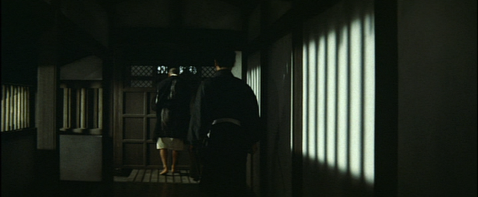
There’s one short scene in the middle of the narrative that I find particularly witty. Just before Musashi enters Hozo-in Temple to challenge the monks there, they force him to sign a document stipulating that he will not seek damages against the temple in case he is injured or maimed in the course of a duel. This sounds to me like a feudal version of the indemnity clause of a modern business contract.
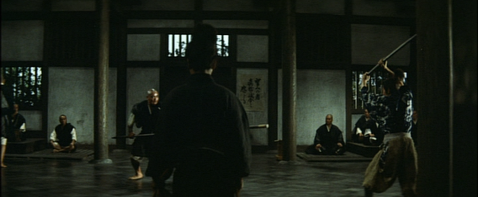
Visually, there are some mildly interesting scenes in this part of the series. Prior to the fight with Agon, Musashi is led down a long corridor – the space is so dark that it looks almost like a black-and-white image – until the viewer arrives with him at the large, round hall where the fight is to take place: a nice quasi-subjective shot in which a restricted space slowly gives way to an expansive one. After this fight, the priest Nikkan, a kind of older surrogate for Takuan, invites Musashi into his humble quarters, and the viewer is treated to some very nice, simple but quite beautiful compositions, possibly inspired by Uchida’s friend, Ozu.
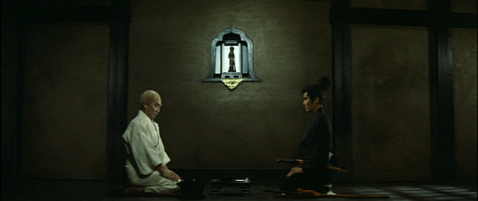
I find it admirable, yet at the same time dispiriting, that Uchida, recognizing he was not working with material on the order of masterpieces like Earth or Hero of the Red-Light District, nevertheless gave every part of this project his all – even while recognizing, as Stuart Galbraith IV reveals in his commentary track for the US DVD release, that the enormous strain of making the series was adversely affecting his already fragile health.9 I would imagine, though, that Uchida must have felt great relief to be done with this installment and eager to go on to the film in which Musashi would finally cross paths with Sasaki Kojirō.
(Continued on Page 3)
[…] The Miyamoto Musashi Series (Miyamoto Musashi, Parts I-V, 宮本武蔵), 1961-1965 January 9,… […]